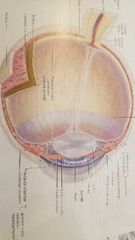![]()
![]()
![]()
Use LEFT and RIGHT arrow keys to navigate between flashcards;
Use UP and DOWN arrow keys to flip the card;
H to show hint;
A reads text to speech;
62 Cards in this Set
- Front
- Back
|
Sensory receptors |
Provide info about external and internal environment, respond to stimuli, |
|
|
Transducer |
Convert stimulus energy into electrical energy.. receptors have a resting membrane potential.. |
|
|
Receptor |
Need receptors to respond, have to transfer to electrical energy |
|
|
General sense receptors |
Somatic and visceral |
|
|
Somatic sensory receptor |
Tactile receptors of joints muscles and tendons |
|
|
Visceral sensory receptors |
In walls of internal organs, monitor strength, chemical environment temperature and pain |
|
|
Special sense receptors |
5.. complex sense organs of the head, of action, gustation, vision, audition, equilibrium |
|
|
Modality of stimulus |
5.. chemoreceptors, thermoreceptors, photoreceptors, mechanoreceptors, nociceptors |
|
|
Chemoreceptors |
Chemicals dissolved in fluids |
|
|
Thermoreceptor |
Change in temperature |
|
|
Photoreceptor |
Changes in light intensity |
|
|
Mechanoreceptors |
Distortion of cell membrane, mechanical movement |
|
|
Nociceptors |
Painful stimuli, somatic -external damage to body, visceral-internal organ damage |
|
|
Tactile receptor |
External, abundant mechanoreceptors, of skin and mucus, tick, wind, anything on skin |
|
|
Tactile meissner corpuscles |
Really light touch and shape, phasic receptors |
|
|
Phantom pain |
Sensation of remove body part, cell body still alive, still have memory, now interrupt before removing limb |
|
|
Olfaction |
Sense of smell, needs moisture, dissolved into air, dissolved into nasal mucus, temporal lobe |
|
|
Olfactory epithelium |
Sensory receptor organ, olfactory nerves translate to brain |
|
|
Olfactory nerves |
CN1 |
|
|
Olfactory bulbs |
Must have pair, moisture, temporal lobe, memory in thalumus |
|
|
Gustation |
Sense of taste, gustatory cells are chemoreceptors CNVII CNIX |
|
|
Vallate |
Vallate papillae largest, but least numerous on tongue |
|
|
Taste buds |
Nerve tissues, must dissolve in water, replace quickly |
|
|
Gustary pathway |
Nueeons project to insula |
|
|
Taste sensations |
5.. sweet, salt, sour, bitter, umami |
|
|
Sweet taste |
Organic compounds like sugar or sweetner |
|
|
Salt |
Metal ions like NA and K |
|
|
Sour |
Acids like vinegar |
|
|
Bitter |
Alkaloids , make gag, back of tongue, unsweet chocolate |
|
|
Umami |
Amino acids, meaty flavor |
|
|
Accessory visual structures |
Eyebrow-nonverbal and sweat control, eyelashes-prevent objects coming into eye, blinking, eyelids, lacrimal apparatus, conjunctiva |
|
|
Lacrimal apparatus |
Lateral sides of eyes, tears to corners of inner eye |
|
|
Conjunctiva |
Covers whole eye except cornea, transparent lining of eye and lid surface |
|
|
Sclera |
White part of eye |
|
|
Cornea |
Covers colored part, no blood, bends light rays |
|
|
Iris |
Colored part |
|
|
Pupil |
Black center, control how much light let in |
|
|
Lens |
Floats, alive in eye, clear, changes shape of light |
|
|
Aquimous humor |
Fluid in eye in front of lens |
|
|
Eye parts |

Needs vitiman A |
|
|
Choroid |
Blood flow between sclera and retina |
|
|
Retina |
Internal layer of eye wall, absorb light rays, convert to nerve signals CNII, photoreceptor cells |
|
|
Fovea centralil |
Perfect vision |
|
|
Blind spot |
Where retina does not exist in back of eye |
|
|
Ciliray body |
Holds lens, muscles |
|
|
Photoreceptor cells |
Rods-black and white, cones-color |
|
|
Macular degeneration |
Physical deterioration of macula lutea, leading cause of blindness, diabetes, infection, hypertension, trauma, lose vision in center of eye |
|
|
Binocular vision |
Both eyes look at same thing |
|
|
Cataracts |
Aging, difficult to focus, cloudy lens, reduce visual clarity and color intensity |
|
|
Vitreous humor |
Transparent fluid behind lens |
|
|
Glaucoma |
Increased intraocular pressure, test with puff of air |
|
|
Emmetropia |
Normal vision |
|
|
Hyperopia |
Far sighted, can't see close, eyeball short |
|
|
Myopia |
Near sighted, eyeball too long |
|
|
Astigmatation |
Unequal curves on refractive surfaces |
|
|
Phototransduction |
Convert light to electrical signals |
|
|
Rods |
Longer and narrower, more numerous, highly sensitive, near edge of retina |
|
|
Cones |
Concentrated at fovea centralis, color, intense light |
|
|
Dark adaptation |
20-30 min, bleached rods must regenerate rhodopsin |
|
|
Light adaptation |
5-10 min, cones initially overstimulated |
|
|
Optic nerves |
Exit back of eye and converge at optic chasm |
|
|
Optic tracts |
Go to thalamus |

